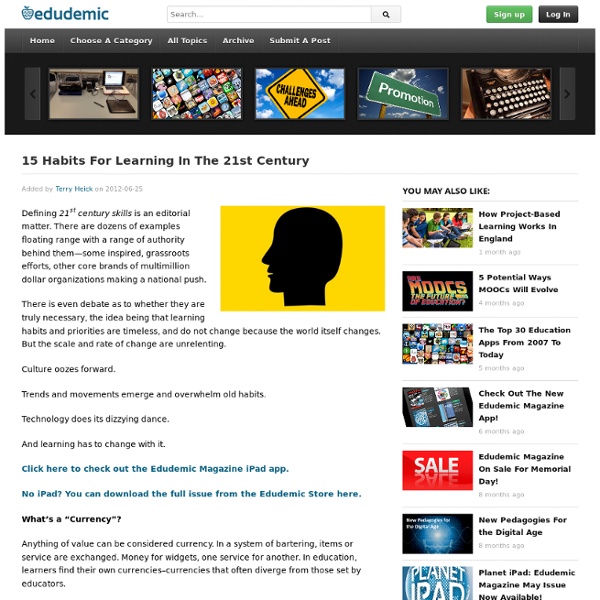14 Habits For Learning In The 21st Century
Defining 21 st century skills is an editorial matter. There are dozens of examples floating range with a range of authority behind them—some inspired, grassroots efforts, other core brands of multimillion dollar organizations making a national push. There is even debate as to whether they are truly necessary, the idea being that learning habits and priorities are timeless, and do not change because the world itself changes. But the scale and rate of change are unrelenting. Culture oozes forward. Trends and movements emerge and overwhelm old habits. Technology does its dizzying dance. And learning has to change with it. Click here to check out the Edudemic Magazine iPad app. No iPad? What’s a “Currency”? Anything of value can be considered currency. The currencies listed below are inspired by a variety of thinkers, in form most of all by Art Costa and Bena Kallick’s excellent Habits of Mind . Edudemic Learning Currencies 2.0
Five close reading strategies to support the Common Core
I walked in to my first college class, Political Science 101, eager to learn. For my inaugural college assignment, my professor asked the class to read the first three chapters of the textbook for the next class period. That night, I returned to my dorm room, determined to learn everything I could in those three chapters. I pulled out my textbook and highlighter. Growing up, that is what I always saw the “older kids” using when they read a textbook. In my naïve 18-year-old mind, I believed that highlighters must have some magical power that transports the words on the page directly to your brain. However, when I opened my textbook it was unlike anything I had read in high school. I shrugged, pulled out my highlighter and started highlighting. I quickly realized that I had no real game plan for reading this complicated textbook. Flash forward to my first few years of teaching. Last fall, I attended an AVID workshop about critical reading strategies. 1. 2. 3. 4. 5. · Ask questions.
Three Questioning Strategies for Any Lesson
Teachers know—questions play a different role, depending on when they're used. Questions are a way to motivate, set goals, stimulate thinking, convey purpose, and create a positive learning environment. Questions inspire thinking and reflection, allow students to review what they're learning, involve students in evaluating their understanding of implicit and explicit learning, and encourage students to think ahead – to predict, anticipate, problem solve, and identify trends and patterns. Questions prompt students to summarize what they learned, make analogies, reflect, draw conclusions, incorporate new learning with prior learning, and extend learning. In her ASCD Annual Conference session, Sandra Page presented several questioning strategies that can be used at all stages of a lesson: On one side of an index card, students write their name large enough to be seen across the room. Student sort cards are also useful for getting students to discuss a topic with one another.
Related:
Related:



